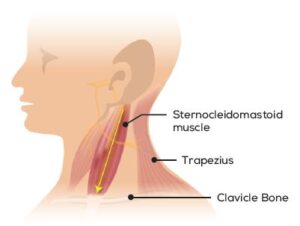
Technology plays a vital role in modern life, but with convenience and utility comes a host of unforeseen problems. Whether you’re looking down at your phone all day or looking up at a wall-mounted television, your posture and neck health is constantly under attack!
Do You Have “Texting Neck”?
“Texting neck” is a new name for an age-old problem. When you frequently hunch over your mobile devices, symptoms like headaches, neck pain, and shoulder pain start to appear and get in the way of your quality of life.
Research has shown the average American sends or receives an average of 41.5 text messages a day! So, you can see there’s ample opportunity to develop neck problems.
Now add in all the time you spend watching videos, checking email, and playing games, and it’s easy to see why so many people are suffering from neck pain associated with technology use.
If you’re concerned about the effect technology is having on your posture and health, read on! We have a fantastic natural solution to relieving the side effects of “texting neck” that has helped countless patients in our clinic (the best part is its super easy to do!).
Symptoms of Texting Neck
Be on the lookout for these symptoms:
- Neck pain
- Stiffness
- Soreness
- Muscular weakness (especially in the trapezius)
- Radiating pain down the arms or shoulders
- Tension headaches
- Spinal degeneration
- Disc compression
It’s critical to remember that texting isn’t the only activity that leads to texting neck. Even reading a book with bad posture can trigger these painful symptoms.
Rest is the Answer, Right? —Wrong.
As one of the pillars of the Hache Protocol For Pain Resolution™, sleep is absolutely essential for healing ANY injury. The problem with neck pain is sufferers often sleep at unnatural angles to avoid pain and discomfort.
This attempt at staying comfortable during the night can eventually lead to more problems in the long run as it can limit blood supply to your head and brain.
Symptoms of low blood flow to the brain:
- Sudden weakness in the limbs
- Loss of balance
- Loss of vision
- Double vision
- Dizziness
- Numbness or a tingling feeling
- Difficulty swallowing
- Slurred speech
- Confusion
- Vomiting
- Nausea
If you’re experiencing any symptoms of restricted blood flow to the brain, seek medical intervention right away.
Enter: “Little Wings”
So, if rest isn’t the answer, the big question is: “what can you do to treat neck pain, such as texting neck, naturally?”
The answer is, Little Wings!
Little Wings is a core Hache Protocol technique that uses microcurrent to target the Sphenoid bone to provide immense relief from issues affecting the neck, shoulders, trapezius, and upper back.
How does it Work?
It all starts with the Sphenoid bone. This bone is crucial to the neck and upper back because all the skull bones rest upon it.

Little Wings Theory posits that if you stimulate the sternocleidomastoid muscle, you can move the Sphenoid bone, you can then move all the other bones of the skull— putting them into proper alignment.
The result? The center of gravity of your skull is reoriented to where it should be.
The benefit? Pain is eliminated!
Why is it Called “Little Wings”?
When done directly, the treatment will cause your shoulders to flap like the wings of a bird.
Be aware- you won’t have control of the contraction of your muscles when performing this protocol. It won’t hurt, but it will feel unfamiliar.
*Little Wings is not appropriate for people with fused neck vertebra or who have had a broken neck.
More than Pain Relief
Little Wings technique will also help you transition out of stress into a relaxed mode. This protocol helps release endorphins, leaving you calm and relaxed.
Benefits of Little Wings
By performing the Little Wings Protocol, you will experience some phenomenal health benefits, including:
- A release in Sphenoid tension
- Corrected vertebrae positions
- Improved circulation to the brain for better cognitive function
- Reduction in fatigue
- Improved leg alignment
- Decreased eye tension
- The elimination of tension headaches
- The elimination of “texting neck”
- A release of endorphins
For a protocol that takes as little as 2 minutes, there is no reason NOT to try it!
How to Perform the Little Wings Protocol
Because it is our mission to help the world break free from the confines and limitations of chronic pain, we are sharing a step-by-step guide to performing Little Wings for FREE!
You will need the following equipment to perform Little Wings:
Little Wings Protocol Step-By-Step Guide
- Set your microcurrent device to 121 Hz.
- Place the Y-Electrode on the shoulder and set the power to a comfortable level.

Note: that you will lose control of your shoulders and will experience slight pulling on your arm. The Little Wings Protocol isn’t harmful, but unexpecting people can be surprised by this sensation.
- Place the electrode behind the ear and bring it down along the sternocleidomastoid muscle where the neck joins with the shoulders. You will then start to feel a flutter or tug on your shoulder. The muscle will contract for a few seconds and then release. That’s one “flap.”
Note: If you feel a sensation, but don’t get the pulling you need, increase the power on your device, and you should see the tugging or “flap” on the shoulder.
- Allow the shoulder to “flap” 5 times, and then remove the electrode from the skin.
- Treat the other side of the neck the same way for another 5 “flaps.”
You’re done!
The Bottom Line:
We’re all much more dependent on our technology than we’d like to admit. It’s time to ensure you won’t develop long-term problems by incorporating the Little Wings Protocol into your routine today!
For guidance and support in performing the Little Wings Protocol, we recommend our private membership program and online training.
Please reach out at 1-888-758-0851 if you have any questions about how Little Wings can treat chronic neck pain associated with technology use or bad posture.





